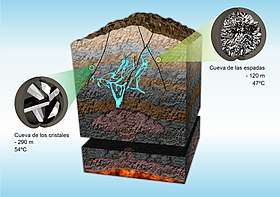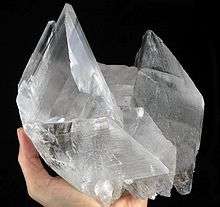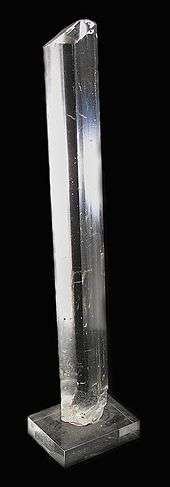Cave of the Crystals
Cave of the Crystals or Giant Crystal Cave (Spanish: Cueva de los cristales) is a cave connected to the Naica Mine at a depth of 300 metres (980 ft), in Naica, Chihuahua, Mexico.
| Cave of the Crystals | |
|---|---|
| Cueva de los cristales | |
Gypsum crystals in the Naica cave. Note person for scale | |
| Location | Naica, Saucillo Municipality, Chihuahua, Mexico |
| Coordinates | 27°51′3″N 105°29′47″W |
| Depth | 300 m (980 ft) |
| Length | 27 m (89 ft) |
| Discovery | 2000 |
| Geology | Limestone |
| Difficulty | Extreme |
| Hazards | High temperature and humidity |
| Access | Now inaccessible |
The main chamber contains giant selenite crystals (gypsum, CaSO4 • 2H2O), some of the largest natural crystals ever found.[1] The cave's largest crystal found to date is 12 m (39 ft) in length, 4 m (13 ft) in diameter and 55 tons in weight. When it was accessible, the cave was extremely hot, with air temperatures reaching up to 58 °C (136 °F)[2] with 90 to 99 percent humidity. The cave is relatively unexplored because of these factors.[3] Without proper protection, people can only endure approximately ten minutes of exposure at a time.[4]
The cave was discovered in April 2000 by brothers Juan and Pedro Sanchez while drilling in the mine. As of October 2015, the mine had reflooded and the cavern filled once more with the water rich in minerals required for the crystals to grow.
A group of scientists known as the Naica Project have been involved in researching these caverns.[5]
Formation of the crystals
Naica lies on an ancient fault above an underground magma chamber which is approximately 3–5 kilometres (2–3 mi) below the cave. The magma heated the ground water which was saturated with sulfide ions (S2−). Cool oxygenated surface water contacted the mineral saturated heated water, but the two did not mix because of the difference in their densities. The oxygen slowly diffused into the heated water and oxidized the sulfides (S2−) into sulfates (SO42−) that precipitated as anhydrite (CaSO4). When the overall temperature of the cave started to drop below 56 °C, the hydrothermal and sedimentary anhydrite crystals dissolved, and gypsum (CaSO4 • 2H2O) crystals formed.[6] The hydrated sulfate gypsum crystallized at an extremely slow rate over the course of at least 500,000 years, forming the enormous crystals found today.[7]
Discovery


In 1910, miners discovered a cavern beneath the Naica Mine workings, the Cave of Swords (Spanish: Cueva de las espadas). It is located at a depth of 120 metres (390 ft), above the Cave of the Crystals, and contains spectacular, smaller (1-metre (3 ft 3 in) long) crystals. It is speculated that at this level, transition temperatures may have fallen much more rapidly, leading to an end in the growth of the crystals.[1]
Giant Crystal Cave was discovered in April 2000 by miners excavating a new tunnel for the Industrias Peñoles mining company located in Naica, Mexico,[8] while drilling through the Naica fault, which they were concerned would flood the mine.[9] The mining complex in Naica contains substantial deposits of silver, zinc and lead.
The Cave of Crystals is a horseshoe-shaped cavity in limestone. Its floor is covered with perfectly faceted crystalline blocks. Huge crystal beams jut out from both the blocks and the floor. The crystals deteriorate in air, so the Naica Project attempted to visually document the crystals before they deteriorated further.[5]
Two other smaller caverns were also discovered in 2000, Queen’s Eye Cave and Candles Cave,[5] and another chamber was found in a drilling project in 2009. The new cave, named Ice Palace, is 150 metres (490 ft) deep and is not flooded, but its crystal formations are much smaller, with small "cauliflower" formations and fine, threadlike crystals.[10]
Exploration and scientific studies

A scientific team coordinated by Paolo Forti, specialist of cave minerals and crystallographer at the University of Bologna (Italy), explored the cave in detail in 2006. To survive and to be able to work in the extreme temperature and humid conditions which prevent prolonged incursion in the crystal chamber, they developed their own refrigerated suits and cold breathing systems (respectively dubbed Tolomea suit and Sinusit respirator). Special caving overalls were fitted with a mattress of refrigerating tubes placed all over the body and connected to a backpack weighing about 20 kilograms (44 lb) containing a reservoir filled with cold water and ice. The cooling provided by melting ice was sufficient to provide about half an hour of autonomy.
Besides mineralogical and crystallographic studies, biogeochemical and microbial characterization of the gypsum giant crystals were also performed. Stein-Erik Lauritzen (University of Bergen, Norway) performed uranium-thorium dating to determine the maximum age of the giant crystals, about 500,000 years.[11][12][13] A team lead by A. E. S. Van Driessche directly measured the growth rates of these giant gypsum crystals using present day water of the Naica. They obtained a growth rate of 1.4 ± 0.2 × 10−5 nm∕s, which is the slowest directly measured normal growth rate for any crystal growth process. Taking into account this rate, the largest crystals would have taken approximately 1 million years to reach their current size.[14]
Penelope Boston (New Mexico Institute of Mining and Technology), speleologist and geomicrobiologist specialist of extremophile organisms, realized sterile sampling of gypsum drillcores by making small boreholes inside large crystals under aseptic conditions. The aim was to detect the possible presence of ancient bacteria encapsulated inside fluid and solid inclusions present the calcium sulfate matrix from its formation. Solid inclusions mainly consist of magnesium and iron oxy-hydroxide, but no organic matter could be found associated with the solid hydroxides. No DNA from ancient bacteria could be extracted from the solid inclusions and amplified by PCR. Microbial studies on fluid inclusions are foreseen to attempt to evidence the presence of ancient micro-organisms in the original fluid solution in which the crystals developed. At the 2017 meeting of the American Association for the Advancement of Science, researchers, including Dr. Boston, announced the discovery of bacteria found in inclusions embedded in some of the crystals. Using sterile methods, the researchers were able to extract and reanimate these organisms, which are not closely related to anything in the known genetic databases.[15] A subsequent report indicated that the microbes could be as old as 50,000 years.[16]
Other researches covered the fields of palynology (pollen study), geochemistry, hydrogeology and the physical conditions prevailing in the Cave of Crystals.
Closure
The cave was featured on the Discovery Channel program Naica: Beyond The Crystal Cave in February 2011.[17] Earlier, it was featured on the History Channel program Life After People, in the episode "Depths of Destruction" of the second season.[18] Exploration has given credence to the existence of further chambers, but further exploration would have required significant removal of the crystals. As the cave's accessibility is dependent on the mine's water pumps, once mining operations ceased, the caves were allowed to re-flood in October 2015.[15]
If the mining company decides to open another entrance, researchers might again enter to continue their work, according to a February 2019 report.[19][20]
See also
References
- Lovgren, Stefan (2007-04-06). "Giant crystal cave's mystery solved". National Geographic News. Archived from the original on 2010-04-14. Retrieved 2010-10-22.
- "Giant Crystal Cave Comes to Light". Archived from the original on 2010-02-09. Retrieved 2010-02-07.
- "A rare glimpse of the cave of crystals". BBC News. 19 January 2010. Archived from the original on 20 January 2010. Retrieved 2010-01-19.
- Shea, Neil (November 2008). "Crystal palace". National Geographic magazine. Archived from the original on 2009-09-06. Retrieved 2009-06-12.
- "Naica Crystals Project". Speleoresearch & Films. Archived from the original on 2007-01-07.CS1 maint: unfit url (link)
- Van Driessche, A.E.S.; Canals, A.; Ossorio, M.; Reyes, R.C.; García-Ruiz, J.M. (2016). "Unravelling the sulphate sources of (giant) gypsum crystals using gypsum isotope fractionation factors". Geology. 124 (2): 235–245. doi:10.1086/684832. hdl:2445/162498.
- Lovgren, Stefan (6 April 2007). "Giant Crystal Cave's Mystery Solved". National Geographic News. Archived from the original on 18 February 2017. Retrieved 19 February 2017.
- "Naica, Mun. de Saucillo, Chihuahua, Mexico". Mindat.org. Archived from the original on 2014-11-16. Retrieved 2014-11-18.
- "Cave of the Giant Crystals, Mexico". Chrystalinks.com. Archived from the original on 2014-12-16. Retrieved 2014-11-18.
- Than, Ker (2010-10-07). "Giant crystal caves yield new "Ice Palace," more". National Geographic News. Archived from the original on 2010-10-16. Retrieved 2010-10-21.
- Stein-Erik, Lauritzen; Constantin Silviu; Paolo Forti (2008). Chronology and growth rate of the Naica giant gypsum crystals. 33rd International Geological Congress (IGC). UiB.
- Sanna, L.; Stein-Erik Lauritzen; Paolo Forti (2009). Preliminary U/Th dating of gypsum crystals from Naica caves (Mexico).
- Sanna, Laura; Paolo Forti; Stein-Erik Lauritzen (2011). "Preliminary U/Th dating and the evolution of gypsum crystals in Naica caves (Mexico)". Acta Carsologica. 40 (1): 17–28. doi:10.3986/ac.v40i1.25. Archived from the original on 2012-04-22. Retrieved 2011-12-31.
- Van Driessche, A.E.S.; García-Ruíz, J.M.; Tsukamoto, K.; Patiño-Lopez, L.D.; Satoh, H. (2011). "Ultraslow growth rates of giant gypsum crystals". PNAS. 108 (38): 15721–15726. doi:10.1073/pnas.1105233108. PMC 3179101. PMID 21911400.
- Amos, Jonathan (2017-02-18). "Naica's crystal caves hold long-dormant life". BBC News. Archived from the original on 2017-02-19. Retrieved 2017-02-18.
- Cave of the Crystals: A Geological Wonder with Giant Shimmering Crystals
- "NAICA: "Beyond the crystal cave and deadly descent" video reveals worlds beneath the Earth's surface, February 13 on Discovery Channel" (Press release). ctvmedia.com. February 8, 2011. Archived from the original on 6 July 2011. Retrieved 18 February 2011.
- "Depths of Destruction". Life After People – Episode Guide. MSN TV. Archived from the original on 2012-09-02. Retrieved 2019-01-12.
- Naica’s crystal cave captivates chemists
- Preserving nature’s wonders 13 JULY 2018
External links
| Wikimedia Commons has media related to Minerals of Naica. |

- Naica Project, comprehensive website on the Crystal Caves with geology, history, photos and videos
- BBC page on the cave with video
- Giant Crystal project
- Crystal Cave of Giants, account of a 2009 visit by George Kourounis